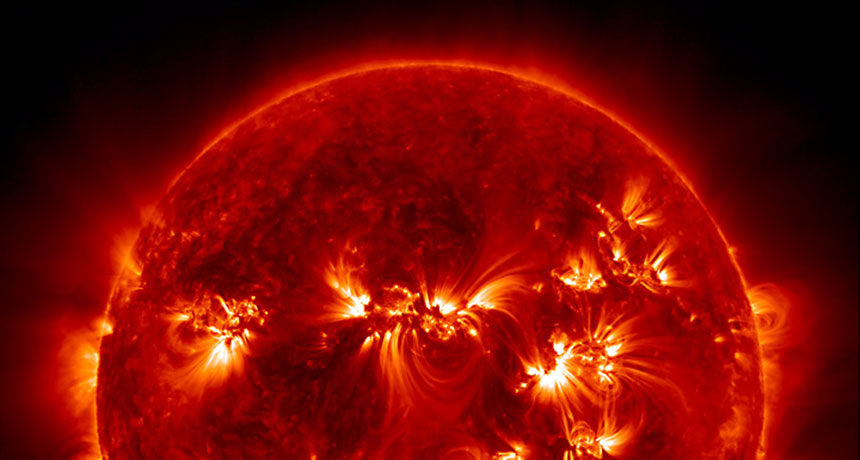
How big is the sun? Well, that depends on when you're measuring.
The sun slightly shrinks and expands as it goes through a solar cycle, a roughly 11-year period of high and low magnetic activity, a new study finds. When the sun is the most active, its radius decreases by 1 or 2 kilometers, two researchers report in a paper accepted in the Astrophysical Journal. Given that the sun's full radius is about 700,000 kilometers, that's a tiny change.
Unlike a planet, the sun has no solid surface, so defining the absolute size isn't simple. "It's a slippery concept: What does it mean, the radius of the sun?" says astronomer Jeff Kuhn of the University of Hawaii in Maui. One way of defining the sun's width is based on how the brightness of the sun decreases from its center. In 2010, Kuhn and colleagues found no signs that the sun's radius varied during the solar cycle, when based on brightness.
But the new study considered a different benchmark called the seismic radius, which is measured via seismic waves that travel through the sun's interior. Any shrinking or expanding of the sun will change the frequency of those waves.
That different yardstick has some advantages. "By using the seismic radius, we can measure more accurately," says Alexander Kosovichev of the New Jersey Institute of Technology in Newark, who coauthored the paper with Jean-Pierre Rozelot of Université Côte d'Azur in Nice, France. To tease out the seismic radius, the astrophysicists used 21 years' worth of data on the waves' frequencies collected by two spacecraft. The amount of expansion or contraction varied by depth: Some layers within the sun contracted while others expanded. But the final result was an overall decrease in seismic radius for a more active sun.
The new measurement, however, is not a replacement for measuring the radius of the sun's brightness. "I think that's a separate question," Kuhn says. The two measurements rely on different techniques, and therefore probe different aspects of the sun's behavior.
Still, the sun's seismic radius may help scientists understand the fluctuating strengths of magnetic fields at different depths within the sun, a potential cause of the shrinkage, says astrophysicist Sabatino Sofia, who is retired from Yale University. While there previously have been hints of variation in the sun's seismic radius, the additional data "really confirms that during the activity cycle, the seismic radius of the sun is changing."
Citations:
A. Kosovichev and J.-P. Rozelot. Cyclic changes of the sun's seismic radius. The Astrophysical Journal, in press, 2018.
Physics writer Emily Conover joined Science News in 2016. She has a Ph.D. in physics from the University of Chicago, where she studied the weird ways of neutrinos, tiny elementary particles that can zip straight through the Earth. She got her first taste of science writing as a AAAS Mass Media Fellow for the Milwaukee Journal Sentinel. She has previously written for Science Magazine and the American Physical Society.



In the last fifteen years the output frequencies have adjusted upwards towards higher lithium and noble gas production. a whiter star than she used to be. The sun changes all the time.